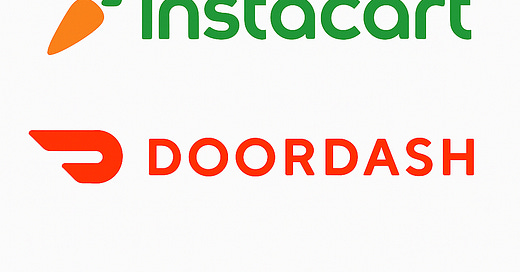Instacart vs. DoorDash: Depth or Scale — Who Wins the Race for Local Commerce?
And which is the Better Investment Today?
For the full two-part 11,000 word deep dive, visit Convequity.
Instacart (CART) and DoorDash (DASH) are two of the most strategically important players in the evolving landscape of last-mile commerce. While both monetize through consumer and merchant fees and are expanding into retail media, their approaches couldn’t be more different — and those differences may define who emerges stronger over the next decade.
Two Models, Two Philosophies
CART is building deep integrations with grocery retailers, aiming to become the digital operating system for how families plan, shop, and eat. Its model is quality-first: a single shopper picks and delivers each order, ensuring item accuracy and personalized service. CART wants to help families eat better, reduce stress, and stay on budget — and it's investing in AI to power that vision.
DASH, on the other hand, is a logistics machine. Born in restaurant delivery, it prioritizes batching, route optimization, and speed. Whether it's sushi, snacks, or shampoo, DASH doesn’t care what’s in the bag — only that it gets delivered quickly and cost-effectively. Its modular approach separates picking and delivery, making it highly scalable across categories and geographies.
Retail Media: A High-Stakes Margin Game
Retail media — ads embedded into the shopping experience — is becoming a critical profit lever. CART has the edge here. Its tight POS integrations, tools like Carrot Tags and Caper Carts, and SKU-level attribution allow it to offer brands real-time, inventory-aware ad placements that convert. Retail media now makes up ~35% of CART’s revenue and ~90% of gross profit.
DASH, meanwhile, is playing catch-up. Most grocery orders are still fulfilled using prepaid Red Cards and limited integration, making ad targeting less precise. That said, DASH’s sheer order volume and high-frequency user base offer promise. If it can scale its retail media capabilities, it could significantly lift gross margins from ~50% to the 65–70% range.
AI: Agentic vs. Operational Intelligence
CART’s AI ambitions are focused on decision-making and personalization. Imagine telling the app: “I’ve got $150, I want low-sodium, gluten-free meals this week,” and CART builds your cart with recipe pairings, substitutions, and delivery logistics. With Fidji Simo now Head of Applications at OpenAI, and still Chair of CART, there's reason to believe CART could lead in agentic AI for household grocery planning.
DASH’s AI is more execution-focused: optimizing order batching, routing, and Dasher efficiency. It’s also experimenting with autonomous delivery via DashMarts, its own micro-fulfillment centers. These proprietary hubs give DASH control over inventory, layout, and — eventually — automation. While not as flashy as CART’s AI assistant vision, this infrastructure could prove critical for long-term margin scalability.
Strategic Control vs. Agility
CART is doubling down on the grocery vertical. It’s embedding into retailers' systems, powering white-label ecommerce, and improving store-level inventory visibility. But that focus comes with tradeoffs. Competition from Amazon/Whole Foods and Walmart looms large, and CART has shown little appetite for geographic or vertical expansion beyond grocery. Its future is tightly tied to its retail partners’ ability to evolve — and that could prove risky.
DASH, by contrast, is aggressively expanding across categories (flowers, convenience, groceries) and geographies. Acquisitions like Wolt (Europe) and Deliveroo (UK) have extended its global reach. DASH’s willingness to onboard grocers without full integration — using prepaid cards and Shop & Deliver models — means it can scale faster, even if it sacrifices some data fidelity and control.
The Investment Case
Valuation is where the story flips. CART, with ~75% gross margins and 23% trailing FCF margin, trades at just 22x EV/FCF (ex-SBC) — suggesting investors are pricing in prolonged stagnation. Yet online grocery penetration in the U.S. is only ~12%, and if CART can grow at 10% with 30% FCF margins, the stock could be worth nearly double.
DASH, growing faster at 20% with 18% FCF margins, trades at a rich 88x EV/FCF. But its execution track record, scale advantage, and global playbook — reminiscent of companies like CrowdStrike or Datadog — make it the more predictable compounder. If it lifts gross margins into the 60s via retail media and automation, the current valuation may be justified.
Who Wins?
If the future shifts toward intentional consumption — health, affordability, AI-assisted planning — CART is structurally better positioned. It’s building deep moats around personalization, grocery loyalty, and ad targeting.
If convenience remains king — fast delivery, category expansion, and operational excellence — DASH’s scale, speed, and adaptability could outpace CART over time.
In truth, both companies may dominate in different verticals. CART has more upside if execution improves and AI adoption accelerates. DASH offers safer compounding through relentless efficiency and broader TAM.
As an investor, the choice comes down to this: depth or scale?




